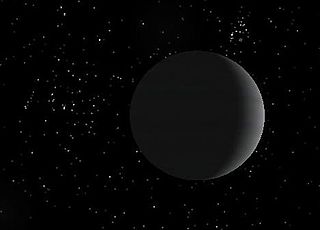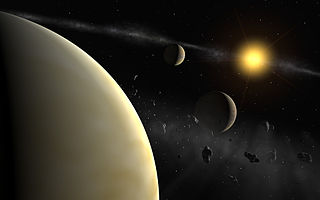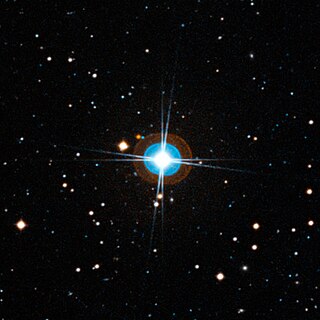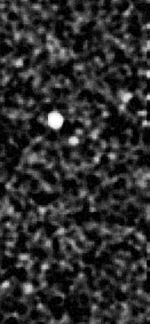
An exoplanet or extrasolar planet is a planet outside the Solar System. The first possible evidence of an exoplanet was noted in 1917 but was not recognized as such. The first confirmation of detection occurred in 1992. A different planet, initially detected in 1988, was confirmed in 2003. As of 1 May 2023, there are 5,366 confirmed exoplanets in 3,962 planetary systems, with 856 systems having more than one planet. The James Webb Space Telescope (JWST) is expected to discover more exoplanets, and also much more about exoplanets, including composition, environmental conditions and potential for life.

An exomoon or extrasolar moon is a natural satellite that orbits an exoplanet or other non-stellar extrasolar body.

HD 28185 b is an extrasolar planet 128 light-years away from Earth in the constellation of Eridanus. The planet was discovered orbiting the Sun-like star HD 28185 in April 2001 as a part of the CORALIE survey for southern extrasolar planets, and its existence was independently confirmed by the Magellan Planet Search Survey in 2008. HD 28185 b orbits its sun in a circular orbit that is at the inner edge of its star's habitable zone.

Mu Arae b, often designated HD 160691 b, formally named Quijote, is an exoplanet orbiting the star Mu Arae of the constellation Ara.

HD 69830 d is an exoplanet likely orbiting within the habitable zone of the star HD 69830, the outermost of three such planets discovered in the system. It is located approximately 40.7 light-years (12.49 parsecs, or 3.8505×1014 km) from Earth in the constellation of Puppis. The exoplanet was found by using the radial velocity method, from radial-velocity measurements via observation of Doppler shifts in the spectrum of the planet's parent star.

A super-Earth is a type of exoplanet with a mass higher than Earth's, but substantially below those of the Solar System's ice giants, Uranus and Neptune, which are 14.5 and 17 times Earth's, respectively. The term "super-Earth" refers only to the mass of the planet, and so does not imply anything about the surface conditions or habitability. The alternative term "gas dwarfs" may be more accurate for those at the higher end of the mass scale, although "mini-Neptunes" is a more common term.

The habitability of natural satellites describes the study of a moon's potential to provide habitats for life, though is not an indicator that it harbors it. Natural satellites are expected to outnumber planets by a large margin and the study is therefore important to astrobiology and the search for extraterrestrial life. There are, nevertheless, significant environmental variables specific to moons.
HD 221287 b, also known as Pipitea, is an exoplanet that orbits HD 221287, approximately 173 light years away in the constellation of Tucana. This planet has mass >3.12 MJ and orbits in a habitable zone at 1.25 AUs from the star, taking 1.25 years to orbit at 29.9 km/s around the star. Dominique Naef discovered this planet in early 2007 by using HARPS spectrograph located in Chile.
HD 33283 b is an exoplanet orbiting around HD 33283. The mass of the planet is about 1/3 that of Jupiter or about the same as Saturn. However, the planet orbits very close to the star, taking only 18 days to complete its orbit with average speed of 86.5 km/s (311400 km/h). Despite this, its orbit is eccentric, bringing it as close as 0.075 AU to the star and as far away as 0.215 AU.
HD 40307 b is an extrasolar planet orbiting the star HD 40307, located 42 light-years away in the direction of the southern constellation Pictor. The planet was discovered by the radial velocity method, using the European Southern Observatory's HARPS apparatus, in June 2008. It is the second smallest of the planets orbiting the star, after HD 40307 e. The planet is of interest as this star has relatively low metallicity, supporting a hypothesis that different metallicities in protostars determine what kind of planets they will form.
HD 40307 c is an extrasolar planet orbiting the star HD 40307, located 42 light-years away in the direction of the southern constellation Pictor. The planet was discovered by the radial velocity method, using the HARPS apparatus, in June 2008. Of the six proposed planets in the HD 40307 star system, it is the third-largest, and has the second-closest orbit from the star. The planet is of interest as this star has relatively low metallicity, supporting a hypothesis that different metallicities in protostars determine what kind of planets they will form.
HD 153950 b is an extrasolar planet located approximately 162 light-years away. This planet was discovered on October 26, 2008 by Moutou et al. using the HARPS spectrograph on ESO's 3.6 meter telescope installed at La Silla Observatory in Atacama desert, Chile.

HD 10180, also designated 2MASS J01375356-6030414, is a Sun-like star in the southern constellation Hydrus that is notable for its large planetary system. Since its discovery, at least six exoplanets have been observed orbiting it, and some studies have proposed up to nine potential planets, which would make it potentially the largest of all known planetary systems, including the Solar System.

An exoplanet is a planet located outside the Solar System. The first evidence of an exoplanet was noted as early as 1917, but was not recognized as such until 2016; no planet discovery has yet come from that evidence. What turned out to be the first detection of an exoplanet was published among a list of possible candidates in 1988, though not confirmed until 2003. The first confirmed detection came in 1992, with the discovery of terrestrial-mass planets orbiting the pulsar PSR B1257+12. The first confirmation of an exoplanet orbiting a main-sequence star was made in 1995, when a giant planet was found in a four-day orbit around the nearby star 51 Pegasi. Some exoplanets have been imaged directly by telescopes, but the vast majority have been detected through indirect methods, such as the transit method and the radial-velocity method. As of 1 May 2023, there are 5,366 confirmed exoplanets in 3,962 planetary systems, with 856 systems having more than one planet. This is a list of the most notable discoveries.

HD 85512 b is a currently-disputed exoplanet orbiting HD 85512, a K-type main-sequence star approximately 37 light-years from Earth in the constellation of Vela.

Kepler-90h is an exoplanet orbiting within the habitable zone of the early G-type main sequence star Kepler-90, the outermost of eight such planets discovered by NASA's Kepler spacecraft. It is located about 2,840 light-years, from Earth in the constellation Draco. The exoplanet was found by using the transit method, in which the dimming effect that a planet causes as it crosses in front of its star is measured.
HD 219134 g, also known as HR 8832 g, is an unconfirmed exoplanet orbiting around the K-type star HD 219134 in the constellation of Cassiopeia. It has a minimum mass of 11 or 15 Earth masses, suggesting that it is likely a Neptune-like ice giant. Unlike HD 219134 b and HD 219134 c it is not observed to transit and thus its radius and density are unknown. If it has an Earth-like composition, it would have a radius 1.9 times that of Earth. However, since it is probably a Neptune-like planet, it is likely larger.
HIP 57274 d is an exoplanet orbiting the K-type main sequence star HIP 57274 about 84.5 light-years (26 parsecs, or nearly 8.022×1016 km) from Earth in the constellation Cetus. It orbits within the outer part of its star's habitable zone, at a distance of 1.01 AU. The exoplanet was found by using the radial velocity method, from radial-velocity measurements via observation of Doppler shifts in the spectrum of the planet's parent star.
HD 240237 b is a super-Jupiter exoplanet orbiting the K-type giant star HD 240237 about 4,900 light-years (1,500 parsecs, or nearly 4.6×1016 km) away from Earth in the constellation Cassiopeia. It orbits outside of the habitable zone of its star at a distance of 1.9 AU. The exoplanet was found by using the radial velocity method, from radial-velocity measurements via observation of Doppler shifts in the spectrum of the planet's parent star. The planet has a mildly eccentric orbit.

HD 89345 b is a Neptune-like exoplanet that orbits a G-type star. It is also called K2-234b. Its mass is 35.7 Earths, it takes 11.8 days to complete one orbit of its star, and is 0.105 AU from its star. It was discovered by 43 astrophysicists, one which is V. Van Eylen, and is announced in 2018.











